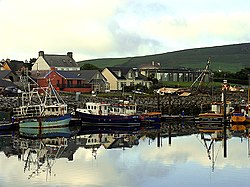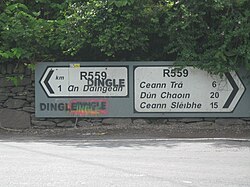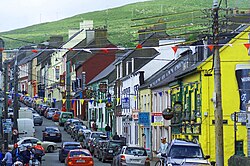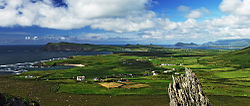Dingle
| Dingle Irish: an Daingean / Daingean Uí Chúis | |
| County Kerry | |
|---|---|
 Harbour of Dingle | |
| Location | |
| Grid reference: | Q445012 |
| Location: | 52°8’24"N, 10°16’18"W |
| Data | |
| Population: | 1,920 (2006) |
| Post town: | Dingle |
| Postcode: | V92 |
| Local Government | |
| Dáil constituency: |
Kerry North |
Dingle is a small coastal town in County Kerry; the only town on the Dingle Peninsula. Its position makes it the westernmost town in Ireland and thus the westernmost town of the British Isles.
Dingle sits on the Atlantic coast, about 30 miles south-west of Tralee and 44 miles north-west of Killarney. Its wealth comes from tourism, fishing and agriculture: Dingle Mart (a livestock market) serves the surrounding countryside. It lies within a Gaeltacht region, the majority of the population in and around the town speaking Irish.
In 2006 Dingle had a population of 1,920.[1]
Contents
Name
"Dingle" is an Anglicisation of the Irish Gaelic name an Daingean meaning "the fort". The town's full Gaelic name is Daingean Uí Chúis, meaning "Fort of O'Cúis".[2]
In 2005, the Minister for Community, Rural and Gaeltacht Affairs, Éamon Ó Cuív, announced that he would use his powers under the Official Languages Act 2003 to abolish anglicised place names of Gaeltacht towns and villages, specifically mentioning Dingle, so that the town's English language name would no longer feature on official signposts, and only the Irish language name would be official. The name "Dingle" was accordingly legally abolished in early 2005 in favour of the Irish name An Daingean.
The move was particularly controversial, as the town relies heavily on the tourist industry, and there was fear that the change could prevent visitors finding the town. The minister added to the controversy by suggesting that if a name change to the English version could be brought about by removing the town's Gaeltacht status, which in turn would end its entitlement to government grants given to Irish-speaking areas. In October 2005, the county council held a plebiscite for the change of name to accept English and Gaelic versions, in which and 1,005 of the 1,086 returned ballots favoured the change to bilingual versions.[3][4] Ó Cuív refused to accept the result as the plebiscite had not status to force him to change his decision, though his opinions were not shared across the Irish Government.[5] To date, the name of the town on road signs within the Gaeltacht displays the name of the town in Irish only, and some locals took matters into their own hands by spray painting "Dingle" on road signs that bore only the Irish version of the name.
Fishing
Dingle is a major fishing port. Fishermen have long set forth from Dingle, but fishing as an industry dates only from about 1830. The 1870s saw major development, when "nobby" fleets from the Isle of Man came in search of mackerel. Lowestoft herring trawlers later joined the fleet, allowing for a longer fishing season. The pier and maritime facilities were developed by the Congested Districts Board for Ireland, and the arrival of rail transport in 1891 allowed for the transport of fish throughout the country, and a canning and curing industry developed.[6]
Places of interest
Dingle's St. Mary's was a neo-Gothic church built to designs by J J McCarthy and O'Connell. The foundation stone was laid in 1862. It originally had a nave and aisles separated by arcades, supported on columns capped by octagonal tops. The arcades were demolished in one of the most radical reordering schemes to have been executed in Ireland. The project also saw the demolition of the exterior walls to below the original clerstory level, and, most notably, of the attic and upper ranges of the west elevation.
There are many opportunities to hear traditional Irish music in the town, particularly during the summer tourist season. Dingle has a number of |pubs as well as restaurants and cafés. There is also an aquarium in the town, and a number of art and craft shops.
Fungi the Dingle Dolphin
Bottlenose dolphins are frequent in the waters off Dingle. Since 1984 a bottlenose dolphin who has come to be known as "Fungi" has frequented the harbour area. Fungi and has become a major attraction for visitors.[7]
Fungi regularly shows up when tour boats go out to meet him. Normally bottlenose dolphins swim in pods, but Fungi seems to prefer human contact rather than interaction with his own species.[8] It is estimated that he was born in the mid 1970s and with a normal life expectancy for his species of 25 years, he is now very old by bottlenose dolphin standards.[9] There is a bronze sculpture of Fungi in Dingle[10]
Sport
Dingle is home to the Dingle GAA club, which plays the Irish game of Gaelic football. The most noted tournament in which Dingle competes is the Kerry Senior Football Championship.[11] Dingle also supplies players to the Kerry GAA county team for the All-Ireland Senior Football Championship.[12] Dingle Gaa Ladies were launched in June 2010
History
Development of the port
The town was developed as a port after Normans came to Ireland. By the thirteenth century more goods were being exported through Dingle than Limerick, and in 1257 an ordinance of Henry III imposed customs on the port's exports.[13]
By the fourteenth century importation of wine was a major business. Maurice FitzGerald, 1st Earl of Desmond, who held palatine powers in the area, imposed a tax on this activity in about 1329.[14] By the sixteenth century Dingle was one of Ireland's main trading ports, exporting fish and hides and importing wines from the continent of Europe. French and Spanish fishing fleets used the town as a base.[14]
Connections with Spain were particularly strong, and in 1529 Thomas Fitzgerald, 11th Earl of Desmond and the ambassador of Charles V of Spain signed the Treaty of Dingle.[15] Dingle was also a major embarkation port for pilgrims to travel to the shrine of Saint James at Santiago de Compostela. The parish church was rebuilt in the sixteenth century under "Spanish patronage" and dedicated to the saint.[16][17]
In 1569 the commerce of the town was increased when it was listed as one of fifteen towns or cities which were to have a monopoly on the import of wine.[14]
The Second Desmond Rebellion
On 17 July 1579 James FitzMaurice FitzGerald, a cousin of the Earls of Desmond, brought a small fleet of ships to Dingle. He made landfall, launching the Second Desmond Rebellion, but was to die soon after in a minor skirmish with the forces of a cousin.[18] The fleet left the town after three days, anchoring at Dún an Óir at the western end of the peninsula, leading eventually to the Siege of Smerwick of 1580.
Walled town and chartered borough
The residents of Dingle applied in 1569 for a "murage grant" to construct walls around the town. The grant was not forthcoming on that occasion. Following the defeat of the Desmond Rebellion, Queen Elizabeth directed that a royal charter be granted to incorporate the town as a borough, and to allow for the construction of walls. Traces of these town walls can still be seen, while the street layout preserves the pattern of burgage plots.[17]
Although Elizabeth intended to grant a charter, the document was only granted in on 2 March 1607 by her successor, King James I, although the borough and its corporation had already been in existence for twenty-two years.[19] The head of the corporation was the sovereign, fulfilling the role of a mayor. In addition to the sovereign, who was elected annually on the Feast of St Michael, the corporation consisted of twelve burgesses. The area of jurisdiction of the corporation was all land and sea within two Irish miles of the parish church. The borough also had an admiralty jurisdiction over Dingle, Ventry, Smerwick and Ferriter's Creek "as far as an arrow would fly".[19]
The charter also created Dingle a parliamentary borough, electing two members to the House of Commons of the Parliament of Ireland.[19]
Linen
Dingle suffered badly in the Nine Years' War and the Wars of the Three Kingdoms, being burnt or sacked on a number of occasions. The town started to recover in the eighteenth century, through the efforts of the Fitzgerald family, Knights of Kerry, who established themselves at "The Grove" at this time. Robert Fitzgerald imported flax seed and by 1755 a flourishing linen industry had been established, with cloth worth £60,000 produced annually. The trade collapsed following the industrial production of cotton in Lancashire, and was virtually extinct by 1837.[20]
Books
- Barrington, T J (1976). Discovering Kerry. Its History, Heritage and Topgoraphy. Cork: The Collins Press. ISBN 1898256713.
- Cuppage, Judith; Bennett, Isabel; Cotter, Claire; O Rahilly, Celie (1986). Archaeological Survey of the Dingle Peninsula. Ballyferriter: Oidhreacht Chorca Dhuibhne. ISBN 0906096065.
- An Daingean Local Area Plan 2006–2012. Tralee: Kerry County Council Planning Policy Unit. 2006. http://cms.kerrycoco.ie/en/allservices/planning/planspolicies/localareaplans/andaingeanlocalareaplan/thefile,739,en.pdf. Retrieved 3 December 2009.
- McKenna, Jack (1985). Dingle. Killarney: Mac Publications.
References
- ↑ "Census 2006 – Volume 1 – Population Classified by Area" (PDF). Central Statistics Office Census 2006 Reports. Central Statistics Office Ireland. April 2007. http://www.cso.ie/census/documents/census2006_volume_1_pop_classified_by_area.pdf. Retrieved 2007-07-24.
- ↑ McKenna 1986:10–11
- ↑ "90% vote in favour of An Daingean name change". RTÉ News. 20 October 2005. http://www.rte.ie/news/2006/1020/daingean.html. Retrieved 2007-07-24.
- ↑ "Do you know the way to An Daingean?". BBC News. 20 October 2006. http://news.bbc.co.uk/1/hi/northern_ireland/6070820.stm. Retrieved 2007-07-24.
- ↑ "Gormley proposes amendments to legislation on changing Placenames - Dingle and Daingean Uí Chúis to be official names of An Daingean". Local Government News. Department of the Environment, Heritage and Local Government. April 2008. http://www.environ.ie/en/LocalGovernment/LocalGovernmentAdministration/News/MainBody,17223,en.htm.
- ↑ Daniel Graham (1996). "History of Fishing on Ireland's Dingle Peninsula". Dingle Peninsula Tourism. http://www.dingle-peninsula.ie/culture1.html. Retrieved 2 December 2009.
- ↑ Do Dingle Fungi article
- ↑ The Irish Independent article Forget Fungi we need Flipper
- ↑ Documentary broadcast by Raidió Teilifís Éireann
- ↑ Geograph.org Statue of Fungi
- ↑ "Dingle football match report". 'The Kingdom' newspaper. July 2005. http://archives.tcm.ie/thekingdom/2005/07/21/story17938.asp. Retrieved 2008-03-25.
- ↑ "Murphy and Griffin appear for Kerry in the All-Ireland football final". RTÉ News. September 2007. http://www.rte.ie/sport/gaa/2007/0916/kerrycork.html. Retrieved 2008-03-25.
- ↑ McKenna 1986:19–20, Coppage et al 1986:380
- ↑ 14.0 14.1 14.2 McKenna 1986:20
- ↑ "The Treaty of Dingle remembered". The Kerryman. 29 April 2009. http://www.kerryman.ie/news/the-treaty-of-dingle-remembered-1723306.html. Retrieved 3 December 2009.
- ↑ McKenna 1986:60
- ↑ 17.0 17.1 Coppage et al, 1986:381
- ↑ McKenna 1986:23
- ↑ 19.0 19.1 19.2 McKenna 1986:31–33
- ↑ McKenna, 1986:45–47



